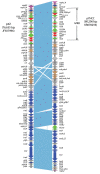Fosfomycin Resistance in Escherichia coli, Pennsylvania, USA
- PMID: 26488485
- PMCID: PMC4622254
- DOI: 10.3201/eid2111.150750
Fosfomycin Resistance in Escherichia coli, Pennsylvania, USA
Abstract
Fosfomycin resistance in Escherichia coli is rare in the United States. An extended-spectrum β-lactamase-producing E. coli clinical strain identified in Pennsylvania, USA, showed high-level fosfomycin resistance caused by the fosA3 gene. The IncFII plasmid carrying this gene had a structure similar to those found in China, where fosfomycin resistance is commonly described.
Keywords: 16S rRNA methyltransferase; ESBL; Escherichia coli; Pennsylvania; United States; antimicrobial resistance; bacteria; extended-spectrum β-lactamase; fosA3 gene; fosfomycin resistance; glutathione S-transferase; plasmids.
Figures


References
-
- Johnson JR, Drawz SM, Porter S, Kuskowski MA. Susceptibility to alternative oral antimicrobial agents in relation to sequence type ST131 status and coresistance phenotype among recent Escherichia coli isolates from U.S. veterans. Antimicrob Agents Chemother. 2013;57:4856–60. 10.1128/AAC.00650-13 - DOI - PMC - PubMed
-
- Wachino J, Yamane K, Suzuki S, Kimura K, Arakawa Y. Prevalence of fosfomycin resistance among CTX-M-producing Escherichia coli clinical isolates in Japan and identification of novel plasmid-mediated fosfomycin-modifying enzymes. Antimicrob Agents Chemother. 2010;54:3061–4. 10.1128/AAC.01834-09 - DOI - PMC - PubMed
-
- Clinical and Laboratory Standards Institute. Performance standards for antimicrobial susceptibility testing; twenty-fourth informational supplement M100–S24. Wayne (PA): The Institute; 2014.
Publication types
MeSH terms
Substances
Grants and funding
LinkOut - more resources
Full Text Sources
Other Literature Sources
Medical

